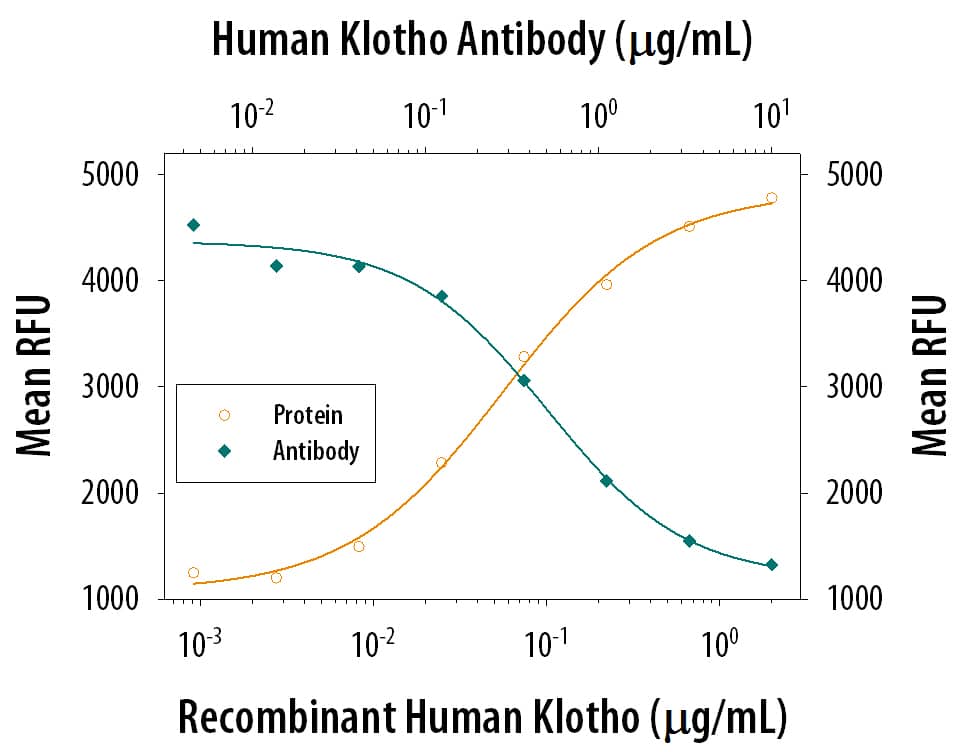Human Klotho Antibody
R&D Systems, part of Bio-Techne | Catalog # MAB5334

Key Product Details
Species Reactivity
Validated:
Human
Cited:
Human, Mouse, Rat, Transgenic Mouse
Applications
Validated:
Neutralization
Cited:
Immunohistochemistry, Immunoprecipitation, Western Blot
Label
Unconjugated
Antibody Source
Monoclonal Rat IgG2B Clone # 775340
Product Specifications
Immunogen
Mouse myeloma cell line NS0-derived recombinant human Klotho
Glu34-Ser981
Accession # Q9UEF7
Glu34-Ser981
Accession # Q9UEF7
Specificity
Detects human Klotho in direct ELISAs. In direct ELISAs, approximately 50% cross-reactivity with recombinant mouse (rm) Klotho (aa 35-982) is observed and no cross-reactivity with rmKlotho (aa 23-550), recombinant human (rh) Klotho beta (aa 53-997), or rhCytosolic beta‑Glucosidase/GBA3 is observed.
Clonality
Monoclonal
Host
Rat
Isotype
IgG2B
Endotoxin Level
<0.10 EU per 1 μg of the antibody by the LAL method.
Scientific Data Images for Human Klotho Antibody
Cell Proliferation Induced by Klotho and Neutralization by Human Klotho Antibody.
Recombinant Human Klotho (Catalog # 5334-KL) induces proliferation in the BaF3 mouse pro-B cell line transfected with human FGF RIIIc in a dose-dependent manner (orange line). Proliferation elicited by Recombinant Human Klotho (0.3 µg/mL) is neutralized (green line) by increasing concen-trations of Rat Anti-Human Klotho Monoclonal Antibody (Catalog # MAB5334). The ND50 is typically 0.15-0.6 µg/mL.Applications for Human Klotho Antibody
Application
Recommended Usage
Neutralization
Measured by its ability to neutralize Klotho-induced proliferation in the BaF3 mouse pro‑B cell line transfected with human FGF RIIIc. The Neutralization Dose (ND50) is typically 0.15-0.6 ug/mL in the presence of 0.3 ug/mL Recombinant Human Klotho.
Formulation, Preparation, and Storage
Purification
Protein A or G purified from hybridoma culture supernatant
Reconstitution
Sterile PBS to a final concentration of 0.5 mg/mL. For liquid material, refer to CoA for concentration.
Formulation
Lyophilized from a 0.2 μm filtered solution in PBS with Trehalose. *Small pack size (SP) is supplied either lyophilized or as a 0.2 µm filtered solution in PBS.
Shipping
Lyophilized product is shipped at ambient temperature. Liquid small pack size (-SP) is shipped with polar packs. Upon receipt, store immediately at the temperature recommended below.
Stability & Storage
Use a manual defrost freezer and avoid repeated freeze-thaw cycles.
- 12 months from date of receipt, -20 to -70 °C as supplied.
- 1 month, 2 to 8 °C under sterile conditions after reconstitution.
- 6 months, -20 to -70 °C under sterile conditions after reconstitution.
Background: Klotho
References
- Nabeshima, Y. (2006) Sci. Aging Knowl. Environ. 8:pe11.
- Kuro-o, M. et al. (1997) Nature 390:45.
- Shiraki-Iida, T. et al. (1998) FEBS Lett. 424:6.
- Imura, A. et al. (2004) FEBS Lett. 565:143.
- Kurosu, H. et al. (2005) Science 309:1829.
- Kurosu, H. et al. (2006) J. Biol. Chem. 281:6120.
- Tsujikawa, H. et al. (2003) Mol. Endocrinol. 17:2393.
- Wu, X. et al. (2007) J. Biol. Chem. 282:29069.
- Chang, Q. et al. (2005) Science 310:490.
- Yamamoto, M. et al. (2005) J. Biol. Chem. 280:38029.
- Liu, H. et al. (2007) Science 317:803.
- Imura, A. et al. (2007) Science 316:1615.
Alternate Names
KL
Gene Symbol
KL
UniProt
Additional Klotho Products
Product Documents for Human Klotho Antibody
Product Specific Notices for Human Klotho Antibody
For research use only
